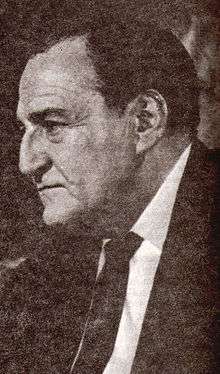1963 Peruvian general election
General elections were held in Peru on 9 June 1963 to elect the President and both houses of the Congress after the results of the 1962 elections were annulled following a military coup.[1] Supported by Popular Action and the Christian Democrat Party, Fernando Belaúnde Terry won the presidential election with 39% of the vote, whilst the Peruvian Aprista Party emerged as the largest party in both houses of Congress.
| ||||||||||||||||||||
| ||||||||||||||||||||
| ||||||||||||||||||||
 |
|---|
| This article is part of a series on the politics and government of Peru |
| Constitution |
|
|
|
|
Autonomies
|
|
|
|
|
|
|
Following a coup on 3 October 1968, no further elections were held until a Constituent Assembly was elected in 1978.[1]
Results
President
| Candidate | Party | Votes | % |
|---|---|---|---|
| Fernando Belaúnde Terry | Popular Action–Christian Democrat Party | 708,662 | 39.1 |
| Víctor Raúl Haya de la Torre | Peruvian Aprista Party | 623,501 | 34.4 |
| Manuel A. Odría | Odriíst National Union | 463,085 | 25.5 |
| Mario Samamé Boggio | Popular Union | 19,320 | 1.1 |
| Invalid/blank votes | 139,716 | – | |
| Total | 1,954,284 | 100 | |
| Registered voters/turnout | 2,070,718 | 94.4 | |
| Source: Nohlen | |||
House of Representatives
| Party | Votes | % | Seats |
|---|---|---|---|
| Peruvian Aprista Party | 56 | ||
| Popular Action | 39 | ||
| Odriíst National Union | 26 | ||
| Christian Democrat Party | 10 | ||
| United Left | 3 | ||
| Pradist Democratic Movement | 2 | ||
| Independents | 3 | ||
| Total | 139 | ||
| Source: Nohlen | |||
Senate
| Party | Votes | % | Seats |
|---|---|---|---|
| Peruvian Aprista Party | 18 | ||
| Popular Action | 15 | ||
| Odriíst National Union | 7 | ||
| Christian Democrat Party | 5 | ||
| Total | 45 | ||
| Source: Nohlen | |||
gollark: "100% harmless" and such do not actually mean "100% harmless" but are a rhetorical thing which just borrows the language of probability for annoying reasons.
gollark: I don't know.
gollark: Apparently running it costs a lot of energy, and humans evolved in an environment where that was a significant problem.
gollark: It kind of makes sense. Causing the immune system to bother more/less or something.
gollark: You mean the other eleventh?
References
- Nohlen, D (2005) Elections in the Americas: A data handbook, Volume II, p454 ISBN 978-0-19-928358-3
This article is issued from Wikipedia. The text is licensed under Creative Commons - Attribution - Sharealike. Additional terms may apply for the media files.

